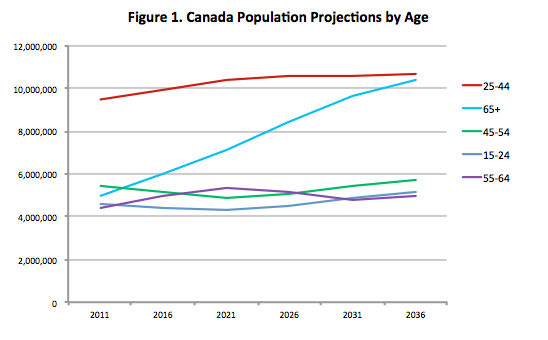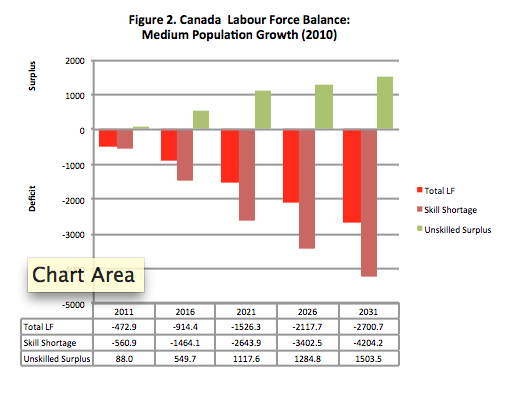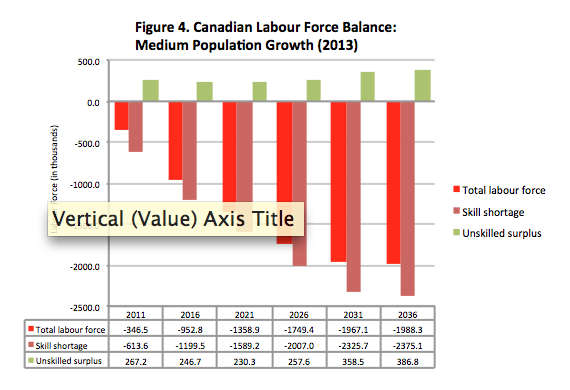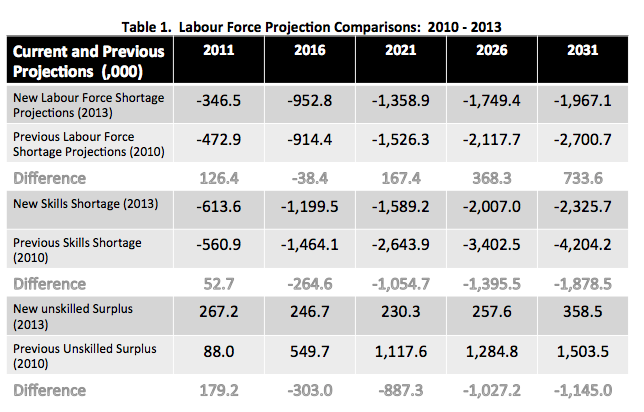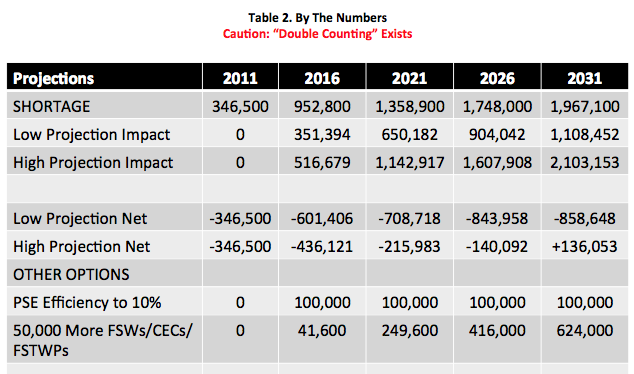Read Canadians and 21st Century Skills | Paper prepared in support of the work of C21 Canada: Canadians for 21st Century Learning and Innovation by Satya Brink, Ph.D
The Canadian Skills Mismatch: DEMOGRAPHIC IMPLICATIONS
By: Dr. Rick Miner on behalf of C21 Canada
INTRODUCTION
According to David Foot and Daniel Stoffman, two internationally renowned demographers, “Demographics explain about two-thirds of everything.” (Boom, Bust & Echo, page 2). Yet, in the case of Canada’s labour market future, one might reasonably push that estimate into the 80th percentile using the 2010 and 2012 reports published by Miner, in the People Without Jobs Jobs Without People series, as the basis for the change. These reports investigated the impact of the baby boomer generation exiting the workforce resulting in significant labour force shortages.
DEMOGRAPHIC PROFILE
Using Statistics Canada projections, Figure 1 provides a visual image of how Canada’s demographic profile will change as the number and proportion of the population 65 and older increases while the primary working age group (25-44) remains relatively stable.
LABOUR FORCE BALANCE 2010
Assuming our labour force size will need to increase in rough proportion to our overall population growth, we will soon experience significant labour force shortages resulting from the fact that retired baby boomers have significantly lower labour force participation rates, and, given current trends, will not be able to be replaced fast enough by members of the younger generations.
These earlier reports projected a Canadian labour force shortage of 2.7 million and a skills shortage of 4.2 million by 2031 (Figure 2).
CHANGES SINCE 2010
Since the publication of these reports a number of dramatic shifts have occurred that warrant a re-analysis of the earlier findings. While the ultimate impact of some changes may not be known for a while, it is worth considering their implications. The changes of most significant note are:
- Labour force participation rates for those 55 and older have increased (largely attributed to our recent economic difficulties).
- The Federal Government has established a number of new immigration programs (Canadian Experience Class, Foreign Skilled Trade Worker Program and the Foreign Skilled Worker Program) targeting younger immigrants who have employment skills and/or Canadian education and training specifically geared to our labour market needs which should increase their labour force participation rates.
- Labour Force demand projections have decreased.
- Recent Statistics Canada data, using 2011 census results, show Canada has achieved educational attainment levels higher than previously projected (Figure 3).
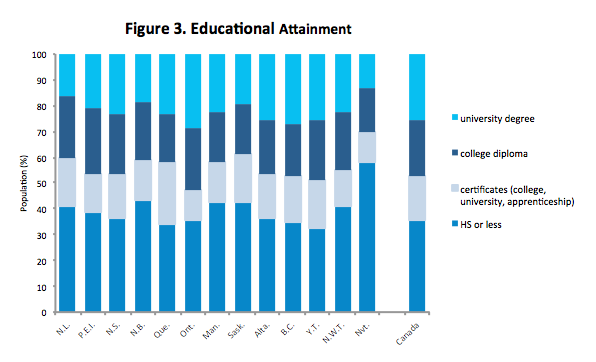 Proposed changes in retirement benefit provisions, moving eligibility from 65 to 67, should keep people in the work force longer.
Proposed changes in retirement benefit provisions, moving eligibility from 65 to 67, should keep people in the work force longer.
- New investments have been made in increasing the educational opportunities for aboriginals and persons with disabilities which should result in a larger and more skilled work force.
LABOUR FORCE BALANCE: A RE-ANALYSIS
Considering these changes and other more current information, a re-analysis of the data was completed and the results are shown in Figure 4. As can be seen, we still have both a labour and a skill shortage, but the situation has improved.
Table 1: Labour Force Projection Comparisons: 2010 -2013 provides a comparison between the earlier and this new data. The projected labour force shortages, skill shortages and projected increased levels of unemployment have improved. However, shortages still exist and they are far from trivial.
Rather than needing an additional 2.7 million workers by 2031 the shortage is now forecasted to be a little less than 2 million. Similarly, projected skills shortages drop significantly from 4.2 million to 2.3 million because of increased educational attainment levels. While the changes are encouraging, we must understand that we have major skill and labour force shortages forthcoming.
In fact, we have a two-headed problem to address in that we not only need more workers, but we need them to have the right skill sets. To increase the size of our work force, it is best to look for employment growth opportunities among those who have historically been under represented in the work force. These are immigrants, aboriginals, persons with disabilities, women, youth and older workers. Yet, we must be cognizant of the fact that these increases need to correspond to areas where skill shortages exist not in areas where there is a surplus. It was earlier assumed that simply having an educational attainment level beyond high school would be sufficient to meet businesses skill requirements. However, as will be discussed later, this assumption was far too simplistic, and will not resolve the skills mismatch problem that does and will exist.
SKILLS MISMATCH
While the debate over the existence or non-existence of a skills mismatch (skills shortage) is taking on epic proportions, many are asking a far too simplistic question (Do supply-demand mismatches currently exist?). Those on the “yes side” include IBM, Canadian Chamber of Commerce, CIBC, a majority of the sector councils, and Engineers Canada to name a few. They support their position by providing estimates showing large projected labour shortages that far exceed existing supply.
Those on the “no side”, tend to concentrate on existing economic data looking at unemployment rates compared to job vacancy rates that show significantly fewer vacancies than those who are unemployed. The assumption here is that if there were shortages then the number of job vacancies would be significantly higher, in proportional terms, to the number of unemployed. Alternatively, they look at occupations in high demand and determine the extent to which wages have increased using the hypothesis that large wage growth indicates a labour shortage (law of supply and demand). While there has been some wage growth in high demand areas the numbers have not been huge. Both approaches are fairly classical economic analysis techniques. Using them one could conclude that there is not now a labour/skills shortage.
It is less clear that these two economic approaches are able to get at the dynamics of our labour market situation for the following reasons. First, the orientation is focused more on the here and now and less so on the future. As has been shown earlier in this report (Table 1), we have experienced some short term labour force relief but our demographic reality will get progressively worse as more and more baby boomers enter retirement.
Second, a here and now analysis must consider the significant increase in the entry of temporary foreign workers to Canada, reported to be over 300,000 in 2012, which, in part, masks the labour shortage. Third, the Labour Force Participation Rate of workers 55 and older has increased which lowers the labour force shortage, which is good, but they will not stay in the work force “indefinitely”, and this reality must be considered.
Given the shortage projections provided by industry and the results of this analysis, one is inclined to accept that in 2011 there was not a major labour shortage but now (2013) one exists and evidence shows that the situation will get progressively worse. In fact, we actually have multiple skill mismatches.
These are
- Supply-demand mismatches which tends to be the focus of the current debate.
- A geographical mismatch (skills in the wrong place) which is becoming increasingly evident as mega projects emerge (oil sands in Alberta, LNG terminals in Northern BC, mine expansions in BC, the Yukon and Ontario, natural resource projects in Manitoba and Saskatchewan, energy projects in Labrador and Quebec, ship building in Vancouver, Halifax and Montreal, and an Eastern pipeline headed to Saint John, NB).
- An underemployment (over skilled) reality particularly among our youth. A recent study by the Certified General Accounts of Canada found that 24.5% of recent university graduates were underemployed. A similar study in the United States found the rate to be 48%.
- Finally, we have another mismatch where the skills of the workers are less than those required of their positions (under skilled/overemployment).
So, in reality, we have multiple mismatches requiring a variety of solutions. First and foremost, we need to increase the overall size of our work force. To do this, as mentioned previously but worth repeating, we need to concentrate our efforts on increasing Labour Force Participations Rates (LFPRs) among under represented groups. Using a “what if analysis”, fully detailed in a forthcoming report by Miner (The Great Canadian Skills Mismatch: People Without Jobs Jobs Without People and MORE), Table 2: By the Numbers shows that with even modest levels of growth in each designated group, we could add another 1.1 million people to the work force by 2031 thus reduction our labour shortage to 858 thousand.
To achieve this would necessitate success in implementing the new immigration programs, improving aboriginal LFPRs to the national average by 2031, reducing the LFPR gap for persons with disabilities by 25% by 2031, reducing the female LFPR gap by 50% by 2031, achieving LFPRs for older workers equal to the current United States averages by 2026, and improving post-secondary efficiencies by 5% by 2016.
The labour force shortfall could be reduced to almost a breakeven point if we were to increase our immigration quota by 50,000, concentrating on younger better skilled workers.
Table 2: By the Numbers also shows the impact of more aggressive objectives in each area of interest. Admittedly these changes will not be automatic and will require some investments, but we need to make them or the consequences will be dire.
RECOMMENDATIONS
So our numerical shortage is solvable but we still need to avoid the skills mismatches by having more of the right people with the right skills in the right place at the right time. To do this, to get the right skill matches, we need to make a number of significant changes. Of particular note are the following:
- We need to drastically improve our Labour Market Information System. The movement to the National Household Survey appears to have had a negative effect on the validity of our data given the significantly lower response rate (68% to 93%). Even without this problem, we face poor educational achievement data which makes it impossible to accurately tie educational attainment to economic outcomes. This makes it difficult to know what resources we have available and how much we need.
- We need a national education and training strategy. To assume that all provinces will engage in educational and training initiatives that are in the best interest of the country is somewhere between naïve and simplistic. The original federal-provincial agreement around educational responsibilities in 1867 had little to do with the value of post-secondary education but rather the role of religion. Being the only G-7 country without a national education strategy should be instructive.
- Career Counselling, assuming we have some good data to convey, should be “mandatory” for all high school students (perhaps even earlier), their parents, teachers and administrators. In addition, it should be used and widely available at colleges, universities and polytechnics.
A variety of college, polytechnic and university changes need to occur. Of particular note are:
1) An increase in coop and intern positions,
2) a restructuring of academic programs such that the applied portion of the program occurs at the end.
3) Redesigning programs so students can delay their specialization (concentration/major) as long as possible to better align their studies to labour market demands.
4) Increase college/polytechnic enrolments by “redirecting” university enrolments to better align the educational/training requirements projected in the future.
5) The establishment of more joint university-college programs with the applied (college/polytechnic) portion of the program occurring at the end.
6) Dissuade enrolment in programs that have limited employment potential given existing labour force demand projections.
7) Grow apprenticeship programs and enrolments.
Business need to get off the sidelines and become more active participants in the whole area of education and training. Aside from supporting more coop and intern opportunities, they need to:
1) provide targeted financial support in areas where they expect increased job growth.
2) Improve hiring practices concentrating more on competencies than credentials.
3) Begin expanding on-the-job training programs to help individuals transition from school to work.
4) Be more forthcoming about actual and anticipated job growth. It is recognized this may require some form of confidential “disclosure” to improve data validity.
Governments, aside from also being an employer, also have a critical role to play. They need to:
1) disproportionally invest in PSE institutions that are providing the educational/training needed for the economy to expand,
2) “force” institutions to realign the balance between their research and teaching mandates which now , disproportionally, favour research,
3) work with educational institutions to help the public better understand that we do not have an educational hierarchy but rather complementary educational systems that provide different but equally valuable educational/training outcomes, and
4) finally, invest in significantly better LMI systems both nationally and provincially.
Space limits a full discussion of the geographical and under/over employment mismatches but most of the solutions, except for some unique geographical challenges, are covered by variations of the suggestions made to address the supply-demand mismatch. A fuller discussion of all options can be found in the forthcoming report.
CONCLUSION
In conclusion, demographic changes, along with increased skill requirements, are the origin of our current and future labour force problems. We will need to BOTH increase the size of our workforce and also insure that we avoid a skills mismatch by aligning our educational attainments to the work force needs that will arise.
While a number of possible solutions have been proposed, it will ultimately require a concerted and cooperative effort between business, government and educational institutions to address and resolve these problems. Resistance to change will be encountered but a solution to these problems will give Canada a significant economic and social advantage as more and more baby boomers enter retirement.
A 21st CENTURY CANADIAN LEARNING, INNOVATION AND SKILLS AGENDA: ISSUES AND CONSIDERATIONS
A C21 CANADA DISCUSSION PAPER
Introduction
In today’s innovation driven and competitive world, highly skilled people are the new economic and social drivers. In this context, two core questions are facing leaders in Canada: How does Canada nurture creative and innovative talent; and how does Canada address the emerging skills gap? On December 3rd, 2013 delegates to the Learning and Skills Roundtable hosted by the Council of Ministers of Education Canada (CMEC) and C21 Canada (C21) had a chance to share views on these two important questions. There is no question that additional dialogue is required. C21 Canada has prepared this Discussion Paper to contribute to the conversation.
The knowledge and digital age is witnessing fundamental and transformational shifts in economies and societies. The need to position Canadians for success within this rapidly shifting environment is highlighting the importance of learning, skills and innovation. A paper commissioned by the Canadian Council of Chief Executives (CCCE) entitled Competing in the 21st Century Skills Race http://www.ceocouncil.ca/publication/competing-in-the-21st-century-skills-race (December 2012) compares Canada’s and China’s performances in three broad areas: general literacy and numeracy; the number of students enrolled in science, technology, engineering and mathematics (STEM) programs; and the development of skills that are considered particularly important for innovation, such as critical and creative thinking, collaboration and adaptability. Recognizing China’s phenomenal performance in these three areas the CCCE paper called for Canada to create a National Roundtable on Skills to develop both a vision for the future and a comprehensive strategy to achieve that vision. The Canadian Chambers of Commerce engaged its members in identifying their current priorities and in its publication The Top Ten Barriers to Competitiveness http://www.chamber.ca/advocacy/Booklet_Top_10_Barriers_2013.pdf (2013) highlights skills and productivity as key priorities for action. The CCC notes that … the need for action is urgent. The standard of living of every Canadian depends on how well we as a people respond to the challenge.
Better understanding the complexities of the learning, skills and innovation challenges is a prerequisite to collaborative action. Despite its growing public profile, few fully understand the nature, scope and inter-related nature of the issues involved. The following commentary is offered as a contribution to the dialogue on this critically important topic. Each section is followed by a question intended to spark the creative thinking of all involved.
21st Century Competencies
In the knowledge and digital age value added knowledge creation drives innovation. Thus, the demand for creative and innovative people highly skilled in using modern digital technologies is escalating. The Organization for Economic Cooperation and Development (OECD) and other international organizations, along with numerous global learning experts, have called for public education systems to be transformed to better engage learners and to nurture a new set of 21st century competencies. The OECD calls for these actions as prerequisites to positioning societies and economies for success in the knowledge and digital era. The need for Canada’s education systems to infuse these 21st century competencies into learning is urgent in the context of sustaining the country’s economic competitiveness and social progress. Current and projected shortages of such talent are emerging as one of the key elements of the global skills gap.
C21 Canada is a national coalition of education and business leaders advocating Canada’s public education systems to be transformed to address this reality. C21 Canada’s Shifting Minds vision document http://www.c21canada.org/ calls for an enhanced focus on 21st century competencies and use of modern technologies to position Canada with creative new leaders and a highly innovative workforce. To date, while Canadians can point to local pockets of innovation in public education, systemic change will demand bold leadership. While the federal government has identified a set of essential skills it feels Canadians require for success in the labour market http://www10.hrsdc.gc.ca/english/ShowProfile.aspx?v=202, more work needs to be done to ensure these essential skills are aligned with the 21st century competencies identified in global research and reflected in C21 Canada’s Shifting Minds vision and framework. And since only provinces and territories have the jurisdictional authority in Canada to implement the changes required in public education, CMEC has a critical national leadership role in advocating for these changes to occur on an urgent basis, in both the provincial and national interest.
What is the future leadership role of CMEC in fostering an accelerated pace of change by calling for 21st century models of learning in all public education systems in Canada?
Demographic Shifts
In his book People Without Jobs Jobs Without People http://tinyurl.com/q6vkhf5 Dr. Rick Miner explains how Canada’s aging demographic means fewer people available for the workforce, creating a gap in available talent for employers. Exacerbating this issue is the relatively low literacy levels of some members of the labour force, limiting their ability to upgrade skills to stay current with changing labour market requirements. In a paper commissioned by C21 Canada, Dr. Miner provides updated information on the impact of demographic shifts on Canada’s labour force (Attached).
What collective response is required by Canadians to lessen the impact of national and regional demographic shifts on meeting the country’s labour force requirements?
Trades
A shortage in the trades sector is perhaps the issue most commonly associated with the skills gap. The genesis of this gap is multi-faceted. First, for years many parents and educators have been discouraging youth from pursuing this career path. The “branding” of trades by society as an inferior choice to higher education has led to less demand from students for trades related training and a shift away from offering such courses in Canada’s high schools. Mike Rowe, a popular actor in the United States, is speaking extensively on this topic http://www.youtube.com/watch?v=ls1YhhMHdNY and has founded an organization to address the issue in that country http://profoundlydisconnected.com/. Rowe contends that society has done a huge disservice by casting trades as a second-rate choice to higher education, when in fact society is increasingly demanding people skilled in trades and the field offers very credible business and employment opportunities. Rowe’s insights on the United States experience parallel the experience in Canada. Fewer entries into trades related fields coupled with baby boomers retiring are creating a gap between supply and labour market requirements. From a regional perspective and according to Statistics Canada http://www.statcan.gc.ca/daily-quotidien/130926/dq130926a-eng.htm there is a growing trend of people moving to western Canada to seek employment. While these western economies often cite the lack of skilled trade people as curtailing growth, the shift westwards of many trade people seeking work and higher wages is creating gaps in the availability of highly skilled trade people in the regions vacated. The decline in apprenticeship training, partially a function of baby boomers inhabiting the available positions for a generation, has exacerbated this issue.
Does Canada need to rebrand trades as a desirable profession, reintroduce trades within public education, and strengthen apprenticeship training opportunities within the private sector?
STEM
Another area of concern to many is in the fields of science, technology, engineering and mathematics (STEM). The root of this challenge is cited as being too few of Canada’s youth pursuing studies and careers STEM related fields. Most of society’s technology innovations originate in these fields and increasing the number of students pursuing STEM related learning and careers is seen as a prerequisite to Canada’s future competitive position. LetsTalkScience, an organization dedicated to promoting science in Canada, has recently published an update on Canada’s STEM related challenges http://www.letstalkscience.ca/our-research/spotlight2013.html.
One of the challenges that must be addressed in the STEM context is the overall disengagement of students in their own learning. The Canadian Education Association (CEA) recently published the results on surveys conducted on students on their level of interest and engagement in school. An infographic on student engagement, http://www.cea-ace.ca/sites/cea-ace.ca/files/cea-2011-wdydist-infographic.pdf illustrates that less than 50% of high school age students felt intellectually engaged in their own learning. Clearly, we need to transform both what we teach (21st century competencies) and how we teach. Essential elements of the new 21st century teaching and learning model include: personalized and inquiry driven learning; and teaching methodologies that are project based, collaborative, ICT empowered and authentic (real world applications). If Canada is to entice more Canadians into STEM related fields, the students must be inspired and find the relevancy to sustain their interest. Although this 21st century model of learning must apply to all areas of public education, it is highly relevant to fostering students interest in pursuing STEM related fields.
How does Canada encourage more of its learners to pursue STEM related fields of study and careers?
Canada’s International Ranking
On October 8, 2013 the OECD released the findings of its inaugural international survey on adult competencies http://www.oecd.org/site/piaac/. The survey provided an unprecedented glimpse into whether the participating countries are equipping their citizens with the competencies and skills they need for success in the 21st Century. CMEC provides Information on the PIAAC results at http://www.piaac.ca/. In a study commissioned by C21 Canada, Satya Brink provides an overview of how the recent PIAAC results relate to C21 Canada’s Shifting Minds position statement and the 21st century competencies contained therein (Attached). Dr. Brink offers specific targets for Canada to aspire to relative to literacy, numeracy and digital competencies. PIAAC shows that while Canada is faring relatively well in international comparative rankings, the country is not among the top performing nations.
On December 3rd, 2013, the OECD released the latest results for the Programme for the International Student Assessment (PISA) in the areas of literacy, numeracy and science. The latest survey, conducted in 2012, focused on numeracy (math). The results show that while Canada remains competitive relative to other nations, there is a consistent downward trend in achievement levels. Together, these international assessments offer Canadians important insights into how their education systems are performing over time and relative to other leading countries, and forecasts Canada’s future in relation to economic competitiveness and social progress. For the PISA results, see: http://www.cmec.ca/252/Programs-and-Initiatives/Assessment/Programme-for-International-Student-Assessment-(PISA)/PISA-2012/index.html.
What action is required to improve Canada’s international rankings in learning and skills development?
What is Real?
A recent study released by the TD bank debunks the notion of a skills gap crisis, noting that the issue is limited to a fairly small number of sectors. The TD report does however call for bold and collaborative action on the skills agenda front.
http://www.td.com/document/PDF/economics/special/JobsInCanada.pdf.
A recent CBC Cross Country Check-Up episode hosted by the popular Rex Murphy focused on the question Does Canada Need A National Jobs Strategy?
http://www.cbc.ca/checkup/episode/2013/11/17/does-canada-need-a-national-jobs-strategy/. One of the questions raised was whether there is a skills gap in Canada, or simply a lack of economic growth resulting in too few jobs being created. The point here is not whether anyone is a fan of the subject show, it is that the issue of learning and skills is complicated while at the same time it is growing in the public conscience, and Canadians will be increasingly looking for to their governments and private sector leaders to provide real direction and concrete solutions.
Conclusions
What does this all mean?
The need for a comprehensive Canadian learning, skills and innovation agenda has never been more apparent. Canada’s competitiveness in a global and innovation driven environment demands a higher level of coordination among the various levels of governments and the private sector than has been the case historically. What is the specific theme that will engender a unified effort? Who convenes the various partners? What form should the discourse take? These are all key questions that must be tackled on an urgent basis.
Global leaders realize that creative leaders and innovative labour forces are pre-requisite to success in the knowledge and digital era. The public profile of learning and skills in Canada is growing. At the same time there is ongoing debate between the federal and provincial levels of government on the priorities for action, with disagreements ranging from the Job Creation Grants model to immigration policy. Aligning Canada’s immigration policy with a national or pan Canadian learning, skills and innovation agenda would appear to be highly strategic. However, in the absence of such an agenda, any question of alignment is moot.
At the same time the need to ensure Canada’s Aboriginal people benefit from an equitable and modern education experience is both a moral and economic imperative. Aboriginal people is the fastest growing sector of Canada’s population and in many of the country’s provinces and territories people of Aboriginal heritage will be essential leaders and contributors to new economic development, the labour market, and social progress. As Canada addresses the need for a learning, skills and innovation agenda, engaging Canada’s Aboriginal leaders in meaningful dialogue in the design and implementation of such an agenda is a prerequisite to success.
The issues are complicated, and yet the prize for a highly collaborative response is Canada’s economic growth and social prosperity. It would appear to be worthy of some dialogue and coordinated effort.
The penultimate question for Canada is twofold: Who will lead and how do we collaborate to accelerate the collective response?
Prepared by:
C21 Canada
WHAT THE OECD PISA RESULTS MEAN FOR CANADA

By John Kershaw, President of C21 Canada, and the former Deputy Minister of Education for New Brunswick
The release of the OECD’s PISA results December 3rd, 2013 http://www.oecd.org/pisa/keyfindings/pisa-2012-results.htm noted that while Canada remains as one of the world’s top performing countries, our overall achievement levels continue to trend downwards. These results are a predictor of our nation’s future prosperity. In the knowledge and digital era, where highly skilled people are the new economic and social drivers, there is legitimate cause for concern.
The implications of the PISA scores were not lost on John Manly, past federal Cabinet member and current president of the Canadian Council of Chief Executives, who was quoted in the Globe and Mail as calling the findings “a national emergency”. While others greeted the results more positively, many Canadian leaders are calling for action.
A Roundtable of Canadian business and finance leaders, convened on the same day as the release of the PISA results, underlined the call for transformative changes to Canada’s education systems. The Roundtable was a joint venture of the Council of Ministers of Education Canada (CMEC) http://www.cmec.ca/and C21 Canada www.c21canada.org . The Honourable Jeff Johnson, the Minister of Education from Alberta and current Chair of CMEC chaired the meeting. The Honourable Alan McIssac, Minister of Education and early Childhood Development joined Minister Johnson at the Roundtable, with Minister Liz Sandals, Minister of Education for Ontario, joining the gathering and sharing the podium with Minister Johnson during the event’s luncheon.
The Roundtable participants shared a number of perspectives. Concern was expressed with the growing disengagement of high school students in their own learning. Others cited the need for an enhanced focus on the quality of teaching. The nature of the skills gap in Canada was similarly addressed. But one message was clear. All the participants are seeking national leadership and a national strategy for education to position Canada for future success.
In Canada, education is a provincial jurisdiction, and as such there is no federal department of education. Thus, it falls to CMEC to provide a national vision and framework for learning in Canada, while recognizing the jurisdictional autonomy of the individual provinces. While this constitutional reality is cited by some as a deterrent to national action, others view the de-centralization of authority as one of Canada’s greatest strengths, both in terms of allowing innovative forms of learning and teaching to emerge, and in aligning learning and skills development with regional priorities.
Notwithstanding the realities of the jurisdictional context for education in Canada, given today’s transformative economic and social realities, more than ever before there is a need for a national vision for education and skills development. And national does not necessarily mean federal. Thus it falls to CMEC to engage Canadians in the design of a 21st century inspired vision and framework for learning and skills development in Canada. Fortunately, the Chair of CMEC and his ministerial colleagues are signalling that they are up to the task. While underlining the fact that the provinces were already aware of and addressing the declining achievement levels reflected in the latest PISA results, Minister Johnson certainly did not dismiss the need for more substantive changes. In fact, it is clear that his leadership in Alberta in designing and implementing that province’s 21st century learning agenda Inspiring Education https://education.alberta.ca/department/ipr/inspiringeducation.aspx makes him well suited to leading CMEC at a defining moment in Canada.
The process of designing this national vision and framework for learning and skills development must be inclusive and collaborative by design. The Roundtable participants were clear; business, finance and other societal leaders want and need to be at the table to help design and implement the national vision and framework. And while national does not mean federal in the context of who leads the process, the process of engagement must include appropriate federal involvement and representation. The federal government does have significant responsibilities and investments that need to be aligned with those of the provinces. Lastly, given that a key success factor will be sustained effort, non political Canadian leaders will have a significant responsibility in holding successive political leaders and their governments accountable for maintaining the agreed upon course.
In today’s innovation driven economy, creative and innovative people with critical thinking skills, the ability to collaborate and adapt to changing circumstances, and thrive in a digital landscape are prerequisites to success. Many participants at the Roundtable highlighted the need for these and other 21st century competencies to be infused into the learning outcomes without losing sight of the foundational importance of and need to improve literacy, numeracy and science achievement levels. Indeed, a representative at the Roundtable from the Canadian Council of Chief Executives noted that a survey of its members showed that these “soft skills” trumped content knowledge as recruitment priorities.
C21 Canada’s Shifting Minds, A Vision and Framework for Learning in the 21st Century, calls for exactly this model of learning for Canada, and is a good place to start the discussion (www.c21caanda.org).
Long recognized as a social priority, education is increasingly being recognized as an economic imperative. Indeed, in the knowledge era, investments in education are investments in the economy. This does not necessarily mean pouring more funding into education; it does mean knowing where and how to invest, aligning education to the needs of society, and shifting your priorities and resources accordingly.
If Canada is to have sustained success in today’s innovation driven world, what we teach, and how we teach must shift to 21st century models of learning, and the nation’s investments in education aligned accordingly. The good news is that we have pockets of innovative learning and teaching excellence through-out Canada. It is time to make these practices the norm, not the exception.
If Canada is to be a global economic and social leader, we need CMEC to show national leadership in designing a vision and framework for learning and skills development in Canada. All Canadians have a stake in this exercise and a responsibility to engage. C21 Canada will continue to support CMEC as it embarks on this important and urgent task.
Peel Board Recognized for 21st Century Learning
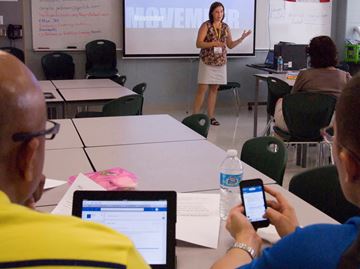 Source: Brampton Guardian
Source: Brampton Guardian
PEEL— Peel District School Board is scheduled to be awarded for its commitment to 21st century learning.
The local school board will receive C21 Canada’s Shifting Minds National Award for distinctive achievement in the field of 21st century learning and innovation. C21 Canada is a national, not for profit organization advocating for 21st century models of learning in education.
In March 2012, Peel school board trustees approved the board’s Vision for 21st Century Teaching and Learning and a $7 million investment in technology to enhance student learning. The plan includes the board’s Bring Your Own Device (BYOD) policy that encourages students to bring portable electronic devices to school for learning purposes and the installation of Wi-Fi at all its schools this past September.
- « Previous Page
- 1
- …
- 10
- 11
- 12
- 13
- 14
- …
- 20
- Next Page »
